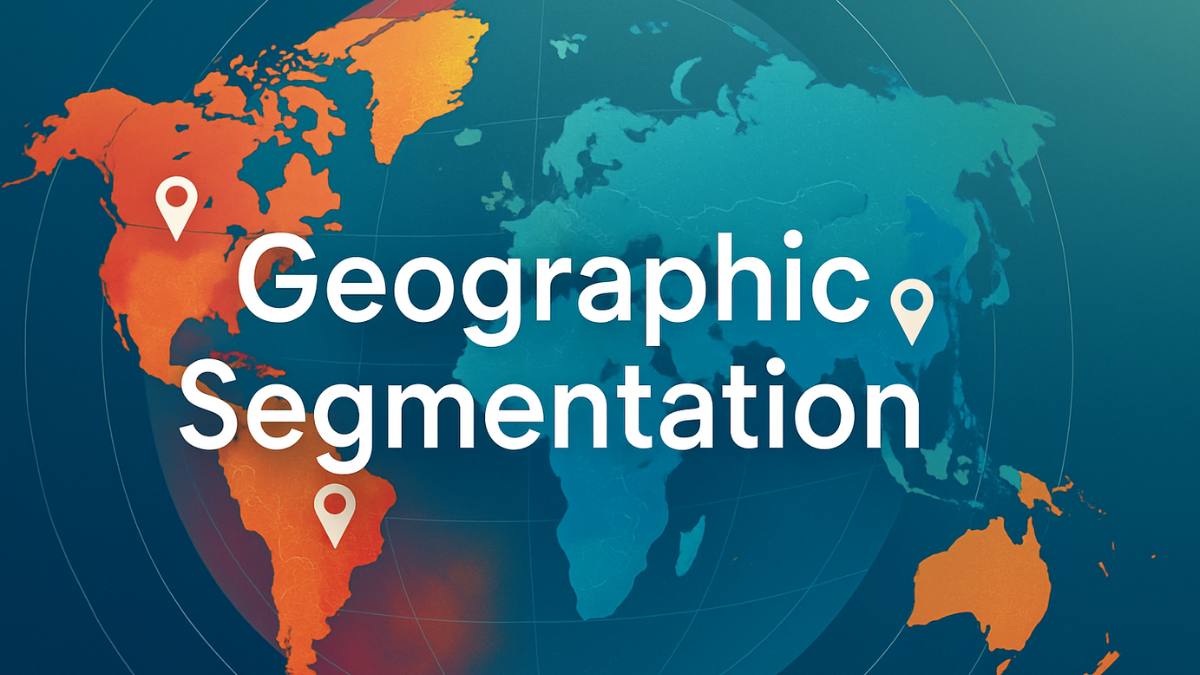Let’s talk segmentation, because no one wants to market blindly anymore.
Market segmentation has been around for ages. It’s the art (and science) of slicing your audience into meaningful groups so you can talk to each group more directly, more personally, and, if we’re being honest, more profitably.
There are a few classic segmentation types: demographic (age, income), psychographic (interests, values), behavioral (purchase patterns), and of course, geographic.
Geographic segmentation might seem like the simplest of the bunch. But don’t mistake “simple” for “basic.” In the right hands, it’s powerful. You’re not just targeting by ZIP code, you’re aligning your entire marketing message to the unique reality of where someone lives.
This blog breaks it all down: what it is, why it matters, how to use it, and some real-world Geographic Segmentation Examples you’ve probably seen without even realizing it.
Table of Contents
What is Geographic Segmentation?
At its core, geographic segmentation is just what it sounds like: dividing your market based on location.
You’re grouping customers by country, state, city, climate, culture, or even something as granular as a neighborhood or time zone.
Think of it like this: someone living in Mumbai doesn’t shop, eat, or even scroll Instagram the same way someone in Copenhagen does. So why would your messaging to them be identical?
How It Works in Marketing
You take location data, sometimes from customer profiles, sometimes from web traffic, IP addresses, delivery zones, or even weather, and use it to customize everything from your ad targeting to your product offering.
It’s not just about relevance. It’s about resonance.
Common Use Cases Across Industries
- Retail: Targeting summer clothes to warmer regions, promoting rainwear in monsoon-heavy states.
- Food & Beverage: Fast food chains tweaking menus based on local tastes.
- Fashion: Seasonal lines launching earlier in cold regions.
- SaaS/Tech: Adjusting features or pricing based on local laws or economic conditions.
- Travel: Dynamic pricing or promotions depending on traveler origin/destination.
Why Use Geographic Segmentation?
If you’ve got a product or message that could vary in relevance by location, geo-segmentation should be on your radar. Here’s why:
Tailored Offerings
Your product might be global, but your customers are local. Geographic data lets you adjust messaging, features, or even entire offerings for different markets.
Better ROI on Campaigns
Why spend money pushing ski jackets to people in Goa? Geo-segmentation ensures your budget is hitting the right people at the right place, and likely at the right time.
Smarter Resource Allocation
You don’t have to blanket your whole customer base with every offer. Use geographic targeting to push localized promotions and content where they’ll work best.
Competitive Advantage
If your competitor is using a one-size-fits-all approach, localized marketing can give you an edge. Local relevance builds trust, and trust drives conversions.
Key Geographic Segmentation Variables
Here’s a breakdown of the key variables you can use when building a geo-based strategy. You might use one or combine several depending on your needs:
| Variable | Description | Example |
| Location | Country, region, state, city, ZIP code | Running a Diwali sale only in India |
| Time Zone | Local time differences | Sending emails at 9am local time across time zones |
| Climate & Weather | Temperature, rainfall, seasons | Promoting raincoats during Kerala’s monsoon season |
| Culture & Local Traditions | Religious festivals, local customs | Marketing modest clothing for conservative regions |
| Urban vs Rural | Population density, infrastructure | Offering high-speed broadband only in metro areas |
| Language & Dialects | Different languages or accents | Serving ads in Hindi in North India and Tamil in Chennai |
Also Read: What is Segmentation in Marketing
Real-World Geographic Segmentation Examples
Example 1: Location-Based Segmentation
Variable: Location – Country / Region / City
Brand: McDonald’s
Let’s start with a classic.
McDonald’s is probably one of the best-known examples of geographic segmentation done right. You walk into a McDonald’s in Chicago, and you’re looking at Big Macs, Quarter Pounders, and lots of beef-heavy items. But do the same in Mumbai? Completely different story. You’ll find the McAloo Tikki, Paneer Burgers, and Chicken Maharaja Mac, not a beef patty in sight.
This isn’t just a menu swap for fun. It’s geographic segmentation that respects local culture, religious sensitivities, and taste preferences. In India, a large portion of the population doesn’t eat beef. So McDonald’s had two options: force their global menu down everyone’s throat… or adapt. They chose wisely.
The result? Deeper market penetration, local love, and a brand that feels a bit more Indian while still being unmistakably McDonald’s.
Key Takeaway: Even global giants need to think local. Location dictates more than logistics, it drives beliefs, habits, and expectations.
Read more about McDonald’s, its marketing strategies, business model and more in our McDonald’s Case Study
Example 2: Time Zone-Based Marketing
Variable: Time Zone
Scenario: Scheduling email marketing or social media content based on local business hours
Let’s say you’re running an eCommerce brand that ships worldwide, maybe it’s a Shopify store selling digital planners or eco-friendly apparel. You’ve built a solid email list that spans from New York to Sydney.
If you blast out a campaign at 9 AM Eastern Time, great, your East Coast audience sees it during coffee time. But your folks in London are already done with lunch, and your Tokyo crowd? They’re asleep.
Brands that are serious about conversions don’t just hit “send” once. They segment their lists by time zone and schedule multiple dispatches, each timed to hit inboxes when people are most likely to open them, usually early morning or around lunch.
Some platforms like Klaviyo, Mailchimp, or ConvertKit even do this automatically now.
Key Takeaway: Same message, better timing = more opens, more clicks, more cash.
Example 3: Climate/Season-Based Campaigns
Variable: Climate & Weather
Brand: Patagonia
Now this one’s a no-brainer. Patagonia sells outdoor gear, jackets, hiking boots, snow gear, you name it. But if you think they send winter jacket ads to everyone in December, you’d be wrong.
Instead, they look at weather patterns and climate zones. So someone in Minnesota (where it’s snowing in October) might start seeing ads for insulated jackets way earlier than someone in Arizona.
And they don’t stop at just product promotions. Patagonia is also known for using localized weather in their content. If there’s a snowstorm coming in Colorado, you might see them push their snow safety gear or winter adventure guides to customers in that area.
Smart, huh?
Key Takeaway: Weather-based marketing isn’t just practical, it feels hyper-relevant to the customer. Like, “Whoa, how did they know I needed this right now?”

Enroll Now: Advanced Digital Marketing Course
Example 4: Cultural Segmentation
Variable: Cultural Norms & Local Traditions
Brand: Netflix
Netflix doesn’t just offer one content library for the world and call it a day. Depending on where you’re located, your recommendations, featured content, and even thumbnails change.
A user in Mexico will see more telenovelas. Someone in South Korea? K-dramas front and center. Indian users get their pick of Bollywood thrillers, regional language films (Tamil, Telugu, Malayalam, you name it), and even culturally specific UI language.
But here’s the genius: they don’t just show what’s available, they push what’s relevant. During Navratri, Netflix India might promote spiritual documentaries or light family films. During Christmas, the UK catalog leans into festive rom-coms.
They use local viewing habits, traditions, and even religious festivals to curate what people see. It’s all automated at scale, but it feels personal.
Key Takeaway: Culture isn’t just about language, it’s about timing, mood, and emotion. Get that right, and you become part of someone’s daily life.
Also Read: Netflix Case Study
Example 5: Urban vs Rural Targeting
Variable: Population Density – Urban vs Rural
Industry: Telecom Providers (like Jio, Airtel, Vi in India)
This one’s a little more behind the scenes but super effective.
Most Indian telecom companies offer different plans based on location, not always openly, but it happens. Urban areas get pushed higher-speed, data-heavy plans. These regions usually have better infrastructure (fiber optic coverage, for instance), so it makes sense.
In contrast, rural areas, where 4G might still be patchy, are often offered plans with lower prices but with fewer perks. Even ad creatives change. Urban campaigns are loaded with streaming benefits (think Netflix tie-ins), while rural ads might emphasize affordability, coverage, or local language support.
Jio literally launched low-cost feature phones for rural areas where smartphones hadn’t penetrated yet. That’s not just product design. That’s geographic and socio-economic segmentation rolled into one.
Key Takeaway: Rural ≠ Urban. Income, access, tech adoption, it all varies. Tailor accordingly, or risk being tone-deaf.
Also Read: 12 Types of Market Segmentation
When and How to Use Geographic Segmentation
Ideal Business Types
- E-commerce: Show relevant delivery timelines or local stock.
- Travel & Tourism: Customize offers by origin/destination.
- FMCG: Seasonal product marketing.
- Local Services: Clinics, gyms, restaurants.
Best Channels for Geo-Segmentation
- Email marketing (via CRM or ESP platforms)
- Google & Facebook Ads (Geo-fenced targeting)
- SMS campaigns
- Push Notifications (on apps with GPS permissions)
Tools & Data Sources
- Google Analytics (Geo reports)
- Facebook Ads Manager (Location targeting)
- CRMs like HubSpot or Zoho (Location tags)
- IP targeting tools
- Weather API integrations (for real-time seasonal promos)
Best Practices for Geographic Segmentation
- Keep geo-data current. People move, preferences evolve.
- Pair geo with other segmentation layers (like behavior or demographic).
- A/B test local content, don’t assume what works in one city will work in another.
- Respect privacy: Be transparent about location tracking and compliant with GDPR, CCPA, etc.
Common Mistakes to Avoid
- Over-segmentation: Don’t break your list into 100 micro-segments unless you can actually serve them differently.
- Ignoring cultural context: Just because two cities speak the same language doesn’t mean they share the same values.
- Country = One Culture fallacy: India, for example, is not one market. Maharashtra ≠ Tamil Nadu ≠ Punjab.
Bad localization: Automated translations often miss nuance. Don’t just translate, adapt.
Conclusion
Geographic segmentation is one of those marketing tactics that seems simple, but can get incredibly strategic once you start exploring the depth of it.
It’s not just about putting people on a map. It’s about understanding that where someone is shapes how they think, what they need, and when they’ll act.
Start small, test by city or region. Layer on climate or culture as you grow. The more locally relevant your message is, the stronger your results will be.
So go on, zoom in on that map. There’s gold in those ZIP codes.
FAQs: Geographic Segmentation Examples
Q1. What industries benefit the most from geographic segmentation?
Travel, retail, food and beverage, real estate, and e-commerce get massive value from geo-segmentation. But honestly? Almost every business can benefit.
Q2. Can small businesses use geographic segmentation effectively?
Absolutely. A local café can target nearby residents with geo-fenced ads, or a small e-comm brand can adjust pricing or delivery messaging by region.
Q3. How is geographic segmentation different from demographic segmentation?
Geographic = where someone is. Demographic = who they are. They often work better together.
Q4. What tools help implement geographic segmentation?
Google Analytics, Facebook Ads Manager, HubSpot CRM, Klaviyo (for email), and IP targeting platforms like Clearbit.
Q5. Can geographic segmentation be used in digital ads like Google or Facebook?
Yes, and it’s super effective. Both platforms let you target down to the city or even a mile-radius around a pin.
Q6. How do I handle overlapping geographic and cultural segments?
Test and observe. Run A/B campaigns and monitor performance. Segment intelligently, but avoid assumptions. Data is your best guide.

